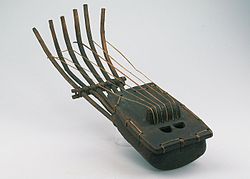West African string instrument
.mw-parser-output .hidden-begin{box-sizing:border-box;width:100%;padding:5px;border:none;font-size:95%}.mw-parser-output .hidden-title{font-weight:bold;line-height:1.6;text-align:left}.mw-parser-output .hidden-content{text-align:left}@media all and (max-width:500px){.mw-parser-output .hidden-begin{width:auto!important;clear:none!important;float:none!important))You can help expand this article with text translated from
the corresponding article in German. (October 2019) Click [show] for important translation instructions.
View a machine-translated version of the German article.
Machine translation, like
DeepL or
Google Translate, is a useful starting point for translations, but translators must revise errors as necessary and confirm that the translation is accurate, rather than simply copy-pasting machine-translated text into the English Wikipedia.
Consider
adding a topic to this template: there are already 9,064 articles in the
main category, and specifying|topic= will aid in categorization.
Do not translate text that appears unreliable or low-quality. If possible, verify the text with references provided in the foreign-language article.
You must provide
copyright attribution in the
edit summary accompanying your translation by providing an
interlanguage link to the source of your translation. A model attribution edit summary is Content in this edit is translated from the existing German Wikipedia article at [[:de:Pluriarc]]; see its history for attribution.
You should also add the template ((Translated|de|Pluriarc)) to the
talk page.
For more guidance, see
Wikipedia:Translation.
Pluriarc |
| Other names | bow lute, paata, mapu, luku, kissanga |
|---|
| Classification |
|
|---|
| Hornbostel–Sachs classification | 321.1
(Bow lute) |
|---|
|
|
Harp, Lute, Musical bow, Masenqo, Gusle, Igil, Krar |
The pluriarc, also called paata, mapu, luku,[1] kissanga, and bow lute[2] is a stringed musical instrument of West Africa, classified as a type of lute. It has a hollow body and several curved, pliable necks made of reeds. The strings stretch from the necks to the bridge, which stands approximately 1.5 inches (38 mm) above the body.[1] The body may be round, rectangular, or triangular, and is usually made of light wood.[3] The top of the body can either be a separate board, bound or nailed to the lower part, or made from the same piece of wood as the rest. A hole may exist on the underside that can be opened or closed to change the timbre.[4]
It is played by plucking the strings, which are usually open but sometimes contain a stop. The strings may be plucked with fingers or a plectrum.[2] The flexible nature of the necks means the instrument cannot be tuned precisely.[3]
Pluriarc designs have been characterized into three types by country of origin: those of southwestern Africa, central west Africa, and western Nigeria.[1]
